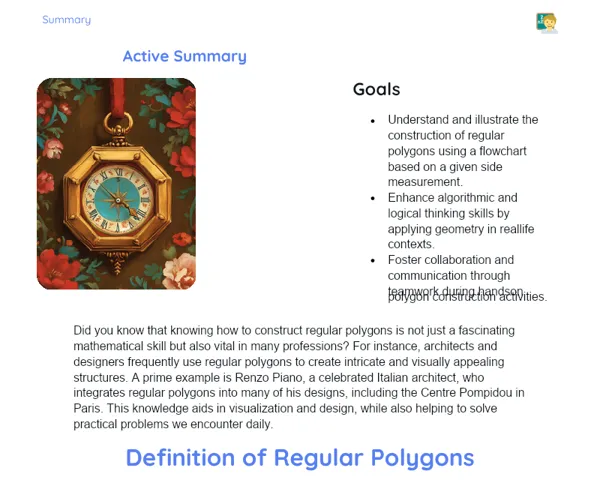Goals
1. Gain a clear understanding of cevians and identify the main types: altitude, median, and angle bisector.
2. Examine the properties of cevians and recognize the notable points: orthocenter, incenter, and centroid.
Contextualization
Triangles are basic geometric figures found across various disciplines and in our everyday lives. Grasping the concept of cevians and the notable points of a triangle is essential, as these aspects are pivotal in addressing optimization and design challenges. Whether it’s in urban planning, constructing bridges, or even in computer graphics, the ideas we'll discuss today are applied to tackle intricate issues and ensure the efficiency and stability of structures.
Subject Relevance
To Remember!
Cevians
Cevians are line segments extending from a vertex of a triangle to the opposite side, or its extension. The main cevians are the altitude, median, and angle bisector, each possessing unique properties and playing an important role in triangle geometry.
-
Altitude: A line segment that is perpendicular to the opposite side.
-
Median: A line segment that connects a vertex to the midpoint of the opposite side.
-
Angle Bisector: A line segment that divides an angle of the triangle into two equal parts.
Notable Points
The notable points of a triangle are where specific cevians intersect. The key ones include the orthocenter, incenter, and centroid—each having distinct attributes and roles in geometry.
-
Orthocenter: The point where the altitudes of the triangle meet.
-
Incenter: The intersection point of the internal angle bisectors of the triangle.
-
Centroid: The intersection point of the medians of the triangle, also regarded as the center of mass.
Properties of Cevians
Cevians have unique characteristics that are crucial for a deeper understanding of triangle geometry. These properties aid in solving geometric challenges and have real-world applications in various sectors.
-
The altitudes of a triangle converge at the orthocenter.
-
The medians of a triangle meet at the centroid, which segments each median in a 2:1 ratio.
-
The internal angle bisectors meet at the incenter, which serves as the center of the triangle's inscribed circle.
Practical Applications
-
In civil engineering, a solid understanding of notable points is key to achieving balance and stability in structures like bridges and buildings.
-
In architecture, cevians and notable points play a vital role in creating designs that are both aesthetically pleasing and structurally sound.
-
In artificial intelligence algorithms, the median of a triangle can be useful for optimizing neural networks.
Key Terms
-
Altitude: A line segment perpendicular to the opposite side of a vertex.
-
Median: A line segment connecting a vertex to the midpoint of the opposite side.
-
Angle Bisector: A line segment that divides an angle of the triangle into two equal angles.
-
Orthocenter: The intersection point of the triangle's altitudes.
-
Incenter: The intersection point of the triangle's internal angle bisectors.
-
Centroid: The intersection point of the triangle's medians, also known as the center of mass.
Questions for Reflections
-
How does understanding the notable points of a triangle affect engineering and architectural initiatives?
-
In what ways can the concepts of altitude, median, and angle bisector assist in solving real-world challenges in the job market?
-
What are the practical consequences of comprehending the centroid's position in balance and center of mass issues?
Construction Challenge: Triangles in Action
In this engaging mini-challenge, you’ll put the concepts of cevians and notable points into practice by creating a physical model of a triangle and identifying its geometric components.
Instructions
-
Gather your materials: skewers, string, hot glue, a ruler, and some markers.
-
Build a triangle using the skewers and hot glue – it can be equilateral, isosceles, or scalene.
-
Identify and mark the cevians (altitude, median, and angle bisector) on the triangle you created.
-
Locate and mark the notable points (orthocenter, incenter, and centroid) on your triangle.
-
Snap photos of your model and the markings you’ve made, and write a brief explanation of how you identified each cevian and notable point.
-
Share your photos and explanations with your classmates, and compare your findings.



